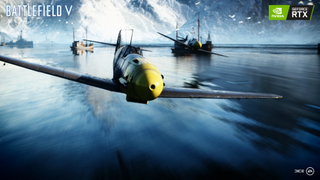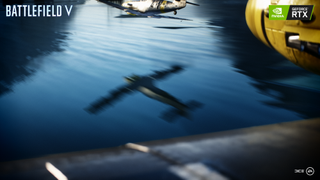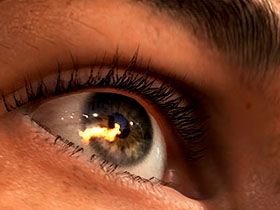Battlefield V Creators: We Toned Down Ray Tracing for Performance, Realism

On September 6th, EA DICE’s Battlefield V officially exits its closed alpha stage and becomes available for everyone to play as an open beta. The game won’t yet support real-time ray tracing, but that’s fine; Nvidia’s Turing-based GeForce RTX 2080 and 2080 Ti graphics cards don’t start shipping until September 20th.
When Battlefield V launches two months later, though, ray tracing will be part of its day-zero patch. Tom's Hardware had the opportunity to sit down with Christian Holmquist, technical director of DICE, to talk about the company's plans for Battlefield V and some of the game's technical capabilities. One key nugget: the company had to dial back the ray tracing technology in order to increase frame rates and make the images look more credible.
The stage demo given by DICE’s team during the Nvidia Gaming Celebration event in Cologne, Germany yielded several impressive examples of how ray tracing improves the realism of what you see in games compared to traditional rasterization techniques like screen space reflection (which is a performance-intensive feature unto itself). With everything moving in slow motion, toggling between ray tracing on and off, the result was truly stunning. We cannot wait to see gaming realism stepped up significantly by the application of real-time ray tracing.

During the demo, certain effects did stand out as if they were exaggerated to showcase Nvidia’s RTX technology, though. Windows in the Rotterdam map were perfectly reflective and paint on the cars was mirror-finished.
DICE’s Holmquist assured us that ray tracing doesn’t change anything about the way art assets are handled in Battlefield V. "What I think that we will do is take a pass on the levels and see if there is something that sticks out," he said. "Because the materials are not tweaked for ray tracing, but sometimes they may show off something that’s too strong or something that was not directly intended. But otherwise we won’t change the levels—they’ll be as they are. And then we might need to change some parameters in the ray tracing engine itself to maybe tone something down a little bit."
Indeed, in one specific scene, DICE dialed back the reflectivity of walls in a room to help improve performance after it was observed that ray tracing hit the frame rate too hard.

Battlefield V Alpha Performance
Stay on the Cutting Edge
Join the experts who read Tom's Hardware for the inside track on enthusiast PC tech news — and have for over 25 years. We'll send breaking news and in-depth reviews of CPUs, GPUs, AI, maker hardware and more straight to your inbox.
Check out Battlefield V Alpha: Our First Gameplay Benchmark Results for early benchmark data from Nvidia's Pascal-based line-up.
DICE is also putting in a lot of work to make sure PC platforms don’t bottleneck Nvidia’s GeForce RTXes. During our interview, Dave James of PCGamesN asked Holmquist what DICE was doing to minimize the impact of ray tracing on Battlefield V.
"So, what we have done with our DXR implementation is we go very wide with a lot of cores to offload that work," Holmquist replied. "So we’re likely going to require a higher minimum spec and recommended spec for using RT, and that was the idea from the start. It won’t affect the gameplay performance, but we might need to increase the hardware requirements a little bit. And going wide is the best way for the consumer in this regard because you can have a four-core or six-core machine. It's a little bit easier these days for the consumer to go wide with more threads than have higher clocks."
It sounds like the engine is optimized for six-core CPUs with simultaneous multi-threading but may work well on 4C/8T processors as well.
GeForce RTX owners should get the option to turn ray tracing off. However, there is no DXR (DirectX Ray Tracing) fallback path for emulating the technology in software on non-RTX graphics cards. And when AMD comes up with its own DXR-capable GPU, DICE will need to go back and re-tune Battlefield V to support it.
Holmquist clarifies, “…we only talk with DXR. Because we have been running only Nvidia hardware, we know that we have optimized for that hardware. We’re also using certain features in the compiler with intrinsics, so there is a dependency. That can be resolved as we get hardware from another potential manufacturer. But as we tune for a specific piece of hardware, dependencies do start to go in, and we’d need another piece of hardware in order to re-tune.”

We also pressed the DICE team on performance differences between its DirectX 11 and DirectX 12 code paths, the former of which is considered faster on Nvidia hardware. Holmquist continued, “We did optimize some paths of DX12, but since most of this work is in the DXR API, what we did was that we made sure none of that was bottlenecking our throughput. So, playing DX12 performance will be similar to what we had in Battlefield 1”.
The option to use DirectX 11 in Battlefield 1 also appealed to gamers with multiple GPUs, since AMD’s CrossFire and Nvidia’s SLI both worked to improve frame rates. Unfortunately, neither technology functioned under DirectX 12. This continues in Battlefield V, as DICE has no plan to support multi-GPU configurations.
We’re actually a bit surprised that DICE eschewed multi-GPU support. Right now, DICE is targeting 1920x1080 at 60 FPS with RTX enabled. Surely, a second GeForce would be a great way to scale such a taxing workload, particularly since Nvidia offers up to two NVLink sub-links with 100 GB/s of bi-directional throughput for card-to-card communication.
While we couldn’t get anyone at Nvidia to comment on dependencies that would preclude a DXR-enabled game from rendering properly in AFR mode, we did ask Epic Games’ Tim Sweeny about hypothetical limitations.
“Multi-GPU scenarios are all workable for ray tracing. There aren’t any new dependencies between frames. The only limiting factor is cost," Sweeny said.
So perhaps as DXR-capable hardware proliferates, game developers will see more upside to supporting multi-GPU configurations, making smooth ray traced performance at 2560x1440 and 3840x2160 realistic sooner than later.
-
dhayric DX12 was supposed to alter the gaming landscape and it hasn't done much. I can't even enable DX12 in BF1 without issues.Reply -
Jeff Fx I've had multi-GPU systems, but the benefit was never really worth the cost, and SLI had to be disabled for a lot of games. I shifted to using the best single-card solution available for maximum performance and least hassle.Reply -
TechyInAZ DHAYRIC, that isn't DX12s fault that's the devs. A great example are games like DOOM (yeah it's vulkan, but DX12 and vulkan are incredibly similar to each other) which runs amazing and is super efficient and reliable.Reply
Glad RT is getting toned down, while graphics are cool, the main part of a video game is actually playing it. Plus, once the hype wears off, you'll care FAR more about the gameplay than the graphics. -
biggjoecheese But....Reply
"When your whole life flashes before your eyes, how much of it do you want to not have ray tracing?"
--Avram Piltch -
bigdragon Let the downgrades begin! Here come the excuses for why the game doesn't look like the promotional demo at the RTX launch.Reply -
drivinfast247 ReplyRight now, DICE is targeting 1920x1080 at 60 FPS with RTX enabled."
I know this is 1st gen software/hardware use, but why bother. Hopefully the normal rasterization performance is much better than 1080ti to make the 2080/ti even slightly worth it. -
Jim90 "One key nugget: the company had to dial back the ray tracing technology in order to increase frame rates and make the images look more credible. "Reply
and
"DICE is targeting 1920x1080 at 60 FPS with RTX enabled."
Firstly, wait for the full reviews!!!
However, this pretty much confirms the size of the gamble NVIDIA is taking.
To see confirmation that RT functionality, as implemented - and in hardware format - takes such a toll that developers have to dial it back just in order to get acceptable frame rates and at 1080p, is a little ominous...particularly when coupled with the pricing structure for these cards and questionable non-RT gains. For all games released under the RT banner, what trust are we to place that the implemented functionality is anything but deliberately crippled.
It's looking more and more likely that this will backfire as a rushed cash grab. -
mortemas I can see both sides of the coin. They want to introduce new tech and as Steve Burke pointed out there is the chicken and egg problem. If they don't make the hardware, the software won't ever be developed. If the software is written and there is no hardware that uses it, well there's no usefulness there either. Plenty of people will still be satisfied with the 1080 ti and I think there will still be a robust market for it due to RTX pricing. Additionally, plenty of people will be willing to buy RTX and give ray tracing a try even if they have to "settle" for 60 fps, LOL. I think they still need to entice half-steppers into the new technology by at least offering some performance improvement in the new cards over the old ones. They need the option to have a better card regardless of ray tracing features. The challenge was to make enough gains in architecture combined with the shrink to 12nm to fit the CUDA cores *and* the new RT cores *and* the new Tensor cores all on the same chip. If you are an RTX buyer then there's no doubt you are funding the new technology, but there needs to be some performance improvement in the old way of rasterized graphics to sweeten the deal and with 12nm and the asynchronous compute I am hoping this is what they achieved. I did feel the same way when I read in the article that reflections looked too perfect. Put some dust and debris on those shiny cars and in the puddles and on the windows - it's a war! My windows aren't that clean!Reply -
winterymix I agree with Mortemas. I don't think RT will be great with this 20xx series of cards, but this series has to exist before better iterations can. It has to start somewhere. Since I'm going to be streaming full time, I'll buy a 2080ti so I have maximum performance, but other than to check it out once or twice, I won't be enabling ray tracing when I stream. If I weren't a full time streamer, I wouldn't be upgrading from my 1000 series card.Reply
Most Popular





